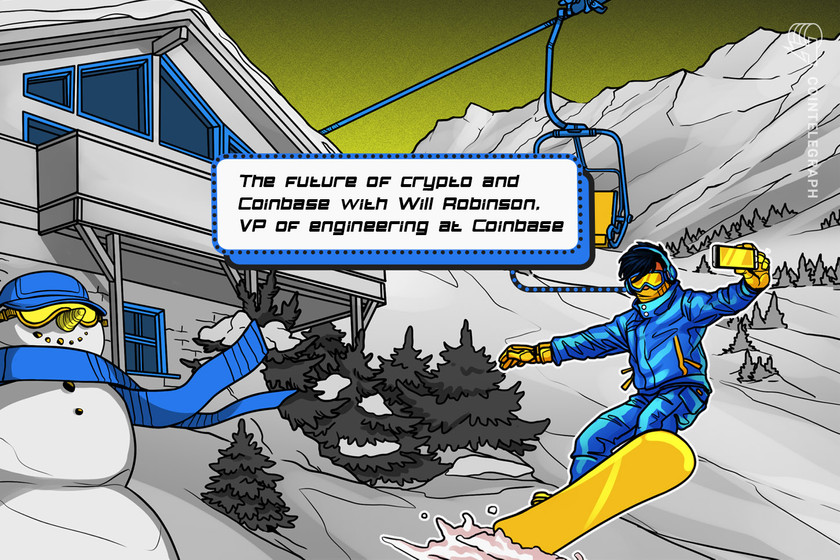- Home
- Tokens
Tokens
Connecting DeFi: How multichain token systems can improve liquidity
Multichain token systems can move tokens between different blockchains, allowing users to access liquidity across multiple markets.
Digital assets are typically restricted to their native blockchain networks, and existing methods of transferring tokens from one blockchain network to another are highly vulnerable to hacking or involve using a trusted third party.
However, multichain tokens enable users to transfer their assets to another blockchain directly without giving up custody of their tokens.
Experts in the blockchain space believe that cross-chain tokens can positively impact the industry by enabling greater user participation over multiple networks.
Marius Ciortan, director of product engineering at Bitpanda and Pantos, a European crypto exchange, told Cointelegraph, “Multichain tokens can establish a more fluid and connected environment in the context of decentralized finance.”
Ciortan continued, “Multichain tokens, for example, can aid in developing more efficient decentralized exchanges by allowing users to trade assets across several blockchain networks. This can aid in improving liquidity and decreasing fragmentation in the DeFi ecosystem.”
Multichain tokens can also help connect blockchain networks, assisting developers in deploying their applications on multiple blockchains. Hoon Kim, chief technology officer at Astar Foundation, a layer-1 smart contract platform, agreed, telling Cointelegraph, “More asset and liquidity interoperability means more interdependence between ecosystems. This can expand the network to allow more innovation and increase the risk of failure when one asset loses its value.”
“But if an asset wants to increase its demand, we can see a future where more and more projects will aim to inject their assets into multiple networks and increase their utility,” Kim said.
Challenges with interoperability
Facilitating communication and interoperability among various blockchain networks heavily relies on interoperability protocols. However, interoperability protocols in the blockchain domain present several challenges that require resolution in order to ensure the seamless operation of the blockchain ecosystem.
The absence of standardization poses a significant obstacle to interoperability protocols. There are many different exchange protocols, and each one has a different design and framework. This means that the environment is full of different networks that don't work together.
Since there isn't much unity, it's hard for developers to make apps that can run on different blockchain networks and still work. Because of this, people who work in software development have to learn how to use different exchange standards, which can take a lot of time.
Scalability is another obstacle to interoperability protocols. Most interoperability protocols are specifically engineered to manage a restricted quantity of transactions, potentially impeding the flow of data in networks that experience high traffic levels.

As a result, the issue of scalability may lead to sluggish transaction processing, elevated fees and network overcrowding.
Recent: Crypto regulation: Does SEC Chair Gary Gensler have the final say?
To tackle this challenge, it is imperative to devise interoperability protocols capable of managing large quantities of transactions and expanding proportionately with the increasing adoption of blockchain technology.
Security is another noteworthy obstacle for interoperability protocols. The interconnectivity of blockchain networks is associated with an elevated likelihood of security breaches and hacks. The absence of security considerations during the design of an interoperability protocol can lead to exploitable vulnerabilities of which malevolent entities can take advantage.
Developers have stressed that it is imperative to design interoperability protocols with resilient security characteristics capable of safeguarding against potential attacks and upholding the authenticity of the blockchain ecosystem.
Ciortan said, “One of the biggest challenges we have seen across all interoperability projects in recent years is ensuring the system's security. Validation of events across multiple chains is a difficult task, and it takes a lot of work and research to develop a system that is robust enough to achieve this goal reliably and can stand the test of time.”
The challenge of addressing the complexity of interoperability protocols is a crucial matter that warrants attention. The intricacy of interoperability protocols necessitates a profound comprehension of cryptography, networking and distributed systems.
To get around these problems, the blockchain community has to work together to develop standards and best practices for interoperability protocols.
Kim also believes security is one of the major challenges concerning interoperability in the blockchain space. Kim said:
“Most bridge protocols are managed through a centralized server that facilitates a burn-and-mint function where the account is controlled via a multi-sig. But recently, we've been seeing a lot of ‘layer 0’ protocols with node validators and virtual machines to connect one blockchain with another.”
Centralized bridge protocols can be vulnerable to hacking, data breaches or other cyber attacks. If the central intermediary or other components of the bridge infrastructure are compromised, it can result in loss of assets, data leaks or other security breaches that can have serious consequences for users.
Since multichain token systems work by users swapping their tokens directly, without any intermediaries or bridges, this can help to address some of the challenges with traditional interoperability protocols.
Operating principles of a multichain token system
The Pantos group has created a novel benchmark called the Pantos Digital Asset Standard (PANDAS). The standard is the principal facilitator of tokens operating across multiple blockchain networks. Based on years of study, the Pantos team has developed a framework that allows tokens to interact smoothly with various blockchains.
Because Pantos is more of an infrastructure layer than a bridge, the PANDAS standard enables developers to deploy their existing tokens and newly created tokens on several blockchains without doing any maintenance work. This indicates that their tokens are on several chains and may be freely moved from one chain to another.
PANDAS does this via smart contracts, which are agreements that carry out themselves when specific circumstances are satisfied. In this scenario, the cross-chain transfer is made possible because of the smart contracts and a network of nodes.
For instance, if someone has an Ethereum-based token and wants to trade it on a BNB Chain DEX, they do not have to depend on a bridge to move a wrapped token to a different chain since they can utilize the Pantos technology to transfer their token to a new chain natively.
How does the multichain verification process work?
Pantos has been developing several validation procedures for a considerable period of time. The ultimate validation method is currently unreleased to the general public; however, it will constitute an enhanced iteration of the oracle-derived methodology.
The approach facilitates enhanced scalability and decreased gas fees while maintaining the system's security standards. Oracles are primarily utilized as instruments for making inquiries. For example, the oracle on a blockchain can be queried by any Pantos client to verify a transaction on a different blockchain.
The Oracle verification process is founded on a combination of threshold signature schemes and distributed key generation (DKG) protocols developed by Dan Boneh, Ben Lynn, and Hovav Shacham — computer scientists at Stanford University. These cryptographic techniques facilitate the authentication of signatories' legitimacy by users. The Boneh-Lynn-Shacham threshold signature allows users to verify that a signer is authentic, and DKG enables multiple parties to contribute to the calculation of a shared public and private key set.
The process is executed with a dual focus on economic and logistical efficiency, achieved through consolidating multiple signatures into a singular signature. In addition, the act of verifying a solitary signature can function as proof that the necessary minimum number of signatories backs the signed correspondence.
Pantos produces a decentralized private key, wherein the oracle nodes possess distinct private key shares, despite lacking ownership of the distributed private key. A public key, in essence, can be deemed analogous to a decentralized private key. Utilizing the private key shares possessed by the oracle nodes, the network can effectively consolidate their discoveries and generate an encoded message that can subsequently be deciphered using the public key.
Related: Building communities and ensuring NFT success: Insights for artists
If the oracle nodes undergo modification, all components, including the private key shares, the distributed private key and the public key, may undergo alteration. Typically, producing new keys necessitates oversight from a trustworthy individual in a position of authority. In contrast, Pantos employs DKG protocols to dispense with the requirement for a dependable authority.
Multichain token systems have the potential to revolutionize the blockchain industry and make DeFi more fluid and connected. By allowing users to transfer assets directly between blockchains without relying on intermediaries or bridges, multichain token systems provide an additional and efficient method for users to engage across multiple blockchain networks.
With Close to 10 Billion Stablecoins Redeemed, BUSD’s Supply Drops to Lowest Level Since April 2021
 Statistics recorded on April 15, 2023, show that the number of coins in circulation for the stablecoin BUSD dropped below the 7 billion range to 6.68 billion, marking the lowest number of BUSD in circulation since April 2021. Furthermore, data indicates that the supply of BUSD has shrunk by 19.8% over the past 30 days. […]
Statistics recorded on April 15, 2023, show that the number of coins in circulation for the stablecoin BUSD dropped below the 7 billion range to 6.68 billion, marking the lowest number of BUSD in circulation since April 2021. Furthermore, data indicates that the supply of BUSD has shrunk by 19.8% over the past 30 days. […]ERC-20 tool recovers $150M — Coinbase exec explains how

Will Robinson, vice president of engineering at Coinbase, explains the crypto exchange’s plan to increase its on-chain presence with new tools and the Base network.
In episode 15 of Cointelegraph’s Hashing It Out podcast, Elisha Owusu Akyaw talks with Will Robinson, vice president of engineering at crypto exchange Coinbase. They discuss the exchange’s vision for the future of the cryptocurrency industry, which is tied to its new Ethereum layer-2 network, Base. Robinson provides updates on the exchange’s latest tools, including an ERC-20 recovery function, wallet as a service and more.
The episode starts with Robinson explaining what his role entails. Robinson explains that he manages the developer product group responsible for internal crypto infrastructure, developer-facing products and protocol-facing efforts. Despite the regulatory activity and “drama in the market,” Robinson believes building in the crypto space has never been this exciting
“I think the world is moving on-chain by default. It is going to happen in fits and starts — on-chain is the new online.“
As part of Coinbase’s plan to build more on-chain tools, the United States-based exchange launched Base, an Ethereum layer-2 network. According to Robinson, Base is a product born out of the exchange’s sturdy movement internally to build more things on-chain. Robinson hopes that Base would become the default on-chain home for Coinbase to steer its users into the larger crypto ecosystem, while partnering with developers to build applications for mass adoption.
The cryptocurrency industry has seen multiple layer-2 networks, such as Arbitrum and Optimism, release their ecosystem tokens. Rumors on social media have tipped Coinbase to release a token for the Base network, but Robinson says there will be no token or airdrop.
Late last year, Coinbase launched an asset recovery tool for users who “mistakenly send unsupported tokens” to exchange addresses. According to Robinson says the ERC-20 recovery tool has been used by over 10,000 users who have recovered over $150 million in assets.
Related: Who watches the watchers? CryptoHarlem founder Matt Mitchell explains why surveillance is the enemy
Robinson also describes the concept behind the wallet-as-a-service product by Coinbase, which is attracting Web2 applications intending to add Web3 features such as digital collectibles or nonfungible tokens.
Listen to the latest episode of Hashing It Out with Will Robinson on Spotify, Apple Podcasts, Google Podcasts, or TuneIn. You can also explore Cointelegraph’s complete catalog of informative podcasts on the Cointelegraph Podcasts page.
Euler Finance attack: How it happened, and what can be learned

The Euler Finance exploit was the largest of Q1 2023, and the risk of a similar attack on other protocols remains.
The March 13 flash loan attack against Euler Finance resulted in over $195 million in losses. It caused a contagion to spread through multiple decentralized finance (DeFi) protocols, and at least 11 protocols other than Euler suffered losses due to the attack.
Over the next 23 days, and to the great relief of many Euler users, the attacker returned all of the exploited funds.
But while the crypto community can celebrate the return of the funds, the question remains whether similar attacks may cause massive losses in the future.
An analysis of how the attack happened and whether developers and users can do anything to help prevent these kinds of attacks in the future may be helpful.
Luckily, Euler’s developer docs clearly explain how the protocol works, and the blockchain itself has preserved a complete record of the attack.
How Euler Finance works
According to the protocol’s official docs, Euler is a lending platform similar to Compound or Aave. Users can deposit crypto and allow the protocol to lend it to others, or they can use a deposit as collateral to borrow crypto.
The value of a user’s collateral must always be more than what they borrow. Suppose a user’s collateral falls below a specific ratio of collateral value to debt value. In that case, the platform will allow them to be “liquidated,” meaning their collateral will be sold off to pay back their debts. The exact amount of collateral a user needs depends upon the asset being deposited vs. the asset being borrowed.
eTokens are assets, while dTokens are debts
Whenever users deposit to Euler, they receive eTokens representing the deposited coins. For example, if a user deposits 1,000 USD Coin (USDC), they will receive the same amount of eUSDC in exchange.
Since they become worth more than the underlying coins as the deposit earns interest, eTokens don’t have a 1:1 correspondence with the underlying asset in terms of value.
Euler also allows users to gain leverage by minting eTokens. But if they do this, the protocol will send them debt tokens (dTokens) to balance out the assets created.
For example, the docs say that if a user deposits 1,000 USDC, they can mint 5,000 eUSDC. However, if they do this, the protocol will also send them 5,000 of a debt token called “dUSDC.”
The transfer function for a dToken is written differently than a standard ERC-20 token. If you own a debt token, you can’t transfer it to another person, but anyone can take a dToken from you if they want to.
Related: Liquidity protocol Sentiment exploited for over $500K
According to the Euler docs, a user can only mint as many eTokens as they would have been able to by depositing and borrowing over and over again, as it states, “The Mint function mimics what would happen if a user deposited $1,000 USDC, then borrowed $900 USDC, then redeposited that $900 USDC, to borrow $810 more USDC, and so on.”
Users liquidated if health scores drop to 1 or below
According to a blog post from Euler, each user has a “health score” based on the value of the eTokens held in their wallets vs. the value of the dTokens held. A user needs to have a greater dollar value of eTokens than dTokens, but how much more depends on the particular coins they are borrowing or depositing. Regardless, a user with enough eTokens will have a health score greater than 1.
If the user barely falls below the required number of eTokens, they will have a health score of precisely 1. This will subject them to “soft liquidation.” Liquidator bots can call a function to transfer some of the user’s eTokens and dTokens to themselves until the borrower’s health score returns to 1.25. Since a user who is barely below the collateral requirements will still have more collateral than debt, the liquidator should profit from this transaction.
If a user’s health score falls below 1, then an increasing discount is given out to the liquidator based on how bad the health score is. The worse the health score, the greater the discount to the liquidator. This is intended to make sure that someone will always liquidate an account before it accumulates too much bad debt.
Euler’s post claims that other protocols offer a “fixed discount” for liquidation and argues why it thinks variable discounts are superior.
How the Euler attack happened
Blockchain data reveals that the attacker engaged in a series of attacks that drained various tokens from the protocol. The first attack drained around $8.9 million worth of Dai (DAI) from the Dai deposit pool. It was then repeated over and over again for other deposit pools until the total amount was drained.
The attacker used three different Ethereum addresses to perform the attack. The first was a smart contract, which Etherscan has labeled “Euler Exploit Contract 1,” used to borrow from Aave. The second address was used to deposit and borrow from Euler, and the third was used to perform a liquidation.
To avoid having to repeatedly state the addresses that Etherscan has not labeled, the second account will be referred to as “Borrower” and the third account “Liquidator,” as shown below:

The first attack consisted of 20 transactions in the same block.
First, Euler Exploit Contract 1 borrowed 30 million DAI from Aave in a flash loan. It then sent this loan to the borrower account.
After receiving the 30 million DAI, borrower deposited 20 million of it to Euler. Euler then responded by minting approximately 19.6 million eDAI and sending it to borrower.
These eDAI coins were a receipt for the deposit, so a corresponding amount of dDai was not minted in the process. And since each eDAI can be redeemed for slightly more than one DAI, the borrower only received 19.6 million instead of the full 20 million.
After performing this initial deposit, borrower minted approximately 195.7 million eDAI. In response, Euler minted 200 million dDAI and sent it to borrower.
At this point, borrower was near their eDAI mint limit, as they had now borrowed about 10 times the amount of DAI they had deposited. So their next step was to pay off some of the debts. They deposited the other 10 million DAI they had held onto, effectively paying back $10 million of the loan. In response, Euler took 10 million dDAI out of borrower’s wallet and burned it, reducing borrower’s debt by $10 million.
Related: Allbridge offers bounty to exploiter who stole $573K in flash loan attack
The attacker was then free to mint more eDAI. Borrower minted another 195.7 million eDAI, bringing their eDAI total minted to around 391.4 million. The 19.6 million eDAI in deposit receipts brought borrower’s eDAI total to about 411 million.
In response, Euler minted another 200 million dDai and sent it to borrower, bringing borrower’s total debt to $400 million.
Once borrower had maximized their eDAI minting capacity, they sent 100 million eDai to the null address, effectively destroying it.
This pushed their health score well below 1, as they now had $400 million in debt vs. approximately $320 million in assets.
This is where the liquidator account comes in. It called the liquidate function, entering borrower’s address as the account to be liquidated.

In response, Euler initiated the liquidation process. It first took around 254 million dDAI from borrower and destroyed it, then minted 254 million new dDai and transferred it to liquidator. These two steps transferred $254 million worth of debt from borrower to liquidator.
Next, Euler minted an additional 5.08 million dDAI and sent it to liquidator. This brought liquidator’s debt to $260 million. Finally, Euler transferred approximately 310.9 million eDAI from borrower to liquidator, completing the liquidation process.
In the end, borrower was left with no eDAI, no DAI, and 146 million dDAI. This meant that the account had no assets and $146 million worth of debt.
On the other hand, liquidator had approximately 310.9 million eDAI and only 260 million dDAI.
Once the liquidation had been completed, liquidator redeemed 38 million eDAI ($38.9 million), receiving 38.9 million DAI in return. They then returned 30 million DAI plus interest to Euler Exploiter Contract 1, which the contract used to pay back the loan from Aave.
In the end, liquidator was left with approx. $8.9 million in profit that had been exploited from other users of the protocol.
This attack was repeated for multiple other tokens, including Wrapped Bitcoin (WBTC), Staked Ether (stETH) and USDC, amounting to $197 million in exploited cryptocurrencies.

What went wrong in the Euler attack
Blockchain security firms Omniscia and SlowMist have analyzed the attack to try and determine what could have prevented it.
According to a March 13 report from Omniscia, the primary problem with Euler was its “donateToReserves” function. This function allowed the attacker to donate their eDAI to Euler reserves, removing assets from their wallet without removing a corresponding amount of debt. Omnisica says that this function was not in the original version of Euler but was introduced in Euler Improvement Proposal 14 (eIP-14).
The code for eIP-14 reveals that it created a function called donateToReserves, which allows the user to transfer tokens from their own balance to a protocol variable called “assetStorage.reserveBalance.” Whenever this function is called, the contract emits a “RequestDonate” event that provides information about the transaction.
Blockchain data shows that this RequestDonate event was emitted for a value of 100 million tokens. This is the exact amount that Etherscan shows were burned, pushing the account into insolvency.

In their March 15 analysis, SlowMist agreed with Omniscia about the importance of the donateToReserve function, stating:
“Failure to check whether the user was in a state of liquidation after donating funds to the reserve address resulted in the direct triggering of the soft liquidation mechanism.”
The attacker might have also been able to carry out the attack even if the donate function had not existed. The Euler “EToken.sol” contract code on GitHub contains a standard ERC-20 “transfer” function. This seems to imply that the attacker could have transferred their eTokens to another random user or to the null address instead of donating, pushing themselves into insolvency anyway.

However, the attacker did choose to donate the funds rather than transfer them, suggesting the transfer would not have worked.
Cointelegraph has reached out to Omniscia, SlowMist and the Euler team for clarification on whether the donateToReserves function was essential to the attack. However, it has not received a response by publication time.
Related: Euler team denies on-chain sleuth was a suspect in hack case
The two firms agreed that another major vulnerability in Euler was the steep discounts offered to liquidators. According to SlowMist, when a lending protocol has a “liquidation mechanism that dynamically updates discounts,” it “creates lucrative arbitrage opportunities for attackers to siphon off a large amount of collateral without the need for collateral or debt repayment.” Omniscia made similar observations, stating:
“When the violator liquidates themselves, a percentage-based discount is applied [...] guaranteeing that they will be ‘above-water’ and incur only the debt that matches the collateral they will acquire.”
How to prevent a future Euler attack
In its analysis, SlowMist advised developers on how to prevent another Euler-style attack in the future. It argued that lending protocols should not allow users to burn assets if this will cause them to create bad debt, and it claimed that developers should be careful when using multiple modules that may interact with each other in unexpected ways:
“The SlowMist Security Team recommends that lending protocols incorporate necessary health checks in functions that involve user funds, while also considering the security risks that can arise from combining different modules. This will allow for the design of secure economic and viable models that effectively mitigate such attacks in the future.”
A representative from DeFi developer Spool told Cointelegraph that technological risk is an intrinsic feature of the DeFi ecosystem. Although it can’t be eliminated, it can be mitigated through models that properly rate the risks of protocols.
According to Spool’s risk management white paper, it uses a “risk matrix” to determine the riskiness of protocols. This matrix considers factors such as the protocol’s annual percentage yield (APY), audits performed on its contracts, time since its deployment, total value locked (TVL) and others to create a risk rating. Users of Spool can employ this matrix to diversify DeFi investments and limit risks.
The representative told Cointelegraph that Spool’s matrix significantly reduced investor losses from the Euler incident.
“In this incident, the worst affected Smart Vaults, those designed by users to seek higher (and riskier) yields, were only affected for up to 35%. The lowest affected vault with exposure to Euler strategies (via Harvest or Idle), in comparison, was only affected by 6%. Some vaults had zero exposure and were thus not impacted,” they stated.
Spool continued, “While this is not ideal, it clearly demonstrates the ability of the Smart Vaults to provide tailored risk models and to distribute users’ funds among multiple yield sources.”
Cointelegraph got a similar answer from SwissBorg, another DeFi protocol that aims to help users limit risk through diversification. SwissBorg CEO Cyrus Fazel stated that the SwissBorg app has “different yield strategies based on risk/timeAPY.”
Some strategies are listed as “1: core = low,” while others are listed as “2: adventurous = risky.” Because Euler was given a “2” rating, losses from the protocol were limited to only a small portion of SwissBorg’s total value locked, Fazel stated.
SwissBorg head of engineering Nicolas Rémond clarified further that the team employs sophisticated criteria to determine what protocols can be listed in the SwissBorg app.
“We have a due-diligence process for all DeFi platforms before entering any position. And then, once we’re there, we have operation procedures,“ he said, adding, ”The due diligence is all about TVL, team, audits, open-source code, TVL, oracle manipulation attack, etc. […] The operation procedure is about platform monitoring, social media monitoring and some emergency measures. Some are still manual, but we’re investing to automatize everything based so that we can be extremely reactive.”
In a March 13 Twitter thread, the SwissBorg team stated that although the protocol had lost 2.2% of the funds from one pool and 29.52% from another, all users would be compensated by SwissBorg should the funds not be recoverable from Euler.
The Euler attack was the worst DeFi exploit of Q1 2023. Thankfully, the attacker returned most of the funds, and most users should end up with no losses when all is said and done. But the attack raises questions about how developers and users can limit risk as the DeFi ecosystem continues to expand.
Some combination of developer diligence and investor diversification may be the solution to the problem. But regardless, the Euler hack may continue to be discussed well into the future, if for no other reason than its sheer size and illustration of the risks of DeFi exploits.
Solana reveals cost-cutting solution for on-chain storage

Known as state compression, the technology promises to drastically reduce the cost of on-chain storage.
Layer-1 blockchain Solana has released a new solution aiming to drastically reduce the cost of on-chain storage. Called state compression, the technology promises to bring down the cost of minting 1 million nonfungible tokens (NFTs) on the network to nearly $110.
"After numerous phases of development, adoption, and rollout, compressed NFTs are live on Solana’s mainnet-beta and powering the next wave of novel on-chain product experiences," said Solana Foundation tech lead Jon Wong in a blog post on April 6. According to Wong, compressed NFTs "are 2,400-24,000x cheaper than uncompressed" peers with identical structures.
1/ Solana's low fees have made it an industry leader. But thanks to a recent innovation from teams across the ecosystem, it's about to cost even less.
— Solana (@solana) April 6, 2023
Introducing state compression, a new way to store data on Solana that lowers cost significantly. https://t.co/0baMJ0vOn1
On Twitter, users classified the state compression solution as a "game changer" and a path "to make Solana a much more viable option for enterprise use cases."
According to Solana's tech lead, state compression relies on Merkle trees, "a data structure known for its capability to 'compress' the verifiability of a tree of data into a 'hash,' or 'fingerprint,' of the current state of the tree." The Merkle roots are stored on-chain and updates are recorded directly in the Solana ledger, reducing the data storage costs without sacrificing decentralization. It can be used to store any sort of data on-chain.
"This compression-friendly data structure allows developers to store a small bit of data on-chain and updates directly in the Solana ledger, cutting the data storage cost down dramatically while still using the security and decentralization of Solana’s base layer," noted Wong.

The development is a "true cross-ecosystem effort," noted Wong. The solution was built by developers at Solana Labs and Metaplex, with support from Phantom, Solflare, and powered by RPC node providers, as well as indexers Helius, Triton, and SimpleHash.
Among the Solana ecosystem projects that already use state compression are Dialect, Crossmint, Helium, and Wordcel. They employ solutions ranging from NFTs minting to integrations for business loyalty programs to improvements in user experience.
Magazine: 4 out of 10 NFT sales are fake: Learn to spot the signs of wash trading
TON validators receive single nominator smart contract

Orbs’ single-nominator contract offers independent validation for validators, safeguards against gas attacks and enables stake recovery during emergencies.
Orbs, a public blockchain infrastructure designed for mass usage applications and close integration, has announced the release of the single nominator smart contract for validators in the Telegram Open Network (TON), a decentralized layer-1 blockchain.
In the TON blockchain network, validators can use the single nominator, which provides an isolated cold wallet for securing their validation process. This feature is particularly useful for validators with enough self-stake to conduct independent validation without needing third-party nominators. This feature aims to enhance validators’ independence, security and protection against gas-spending attacks.
In blockchain technology, a nominator is an individual or entity participating in a proof-of-stake consensus algorithm. This is done by staking their cryptocurrency holdings to support the network’s security and transaction processing.
The nominator essentially nominates a validator to represent their stake in the network and earn rewards on their behalf. The validator, in turn, is responsible for validating transactions and adding new blocks to the blockchain. This process is essential to the security and efficiency of the blockchain network, as it ensures that only legitimate transactions are processed and recorded on the blockchain.
Smart contracts typically involve two or more parties agreeing on a set of rules or conditions that must be met before the contract can be executed. These rules are encoded into the smart contract, and when the specified conditions are met, the contract executes automatically, transferring funds or assets between the parties involved.
The single nominator smart contract provides an option for the core team’s nominator pool smart contract. The alternative was developed in-house to provide security for validators who stake their funds. The single nominator tool is now offered to the community as a free, open-source product.
Related: TON blockchain freezes $2.6B worth of inactive tokens
Orbs added that the single nominator contract offers protection against attack methods by keeping the validator node’s hot wallet separate from the principal staking funds. This separation safeguards the funds against gas spending attacks, and the owner can alter the validator address if the wallet is compromised. Moreover, the contract provides the ability to recover stakes during emergencies, such as elector upgrades.
The contract has been audited by CertiK, a Web3, blockchain and smart contract security firm, which recently announced a partnership with TON to audit future projects on the network.
Magazine: Green consumers want supply chain transparency via blockchain
INX security token platform gets its first token from a public company, Greenbriar

INX security tokens exist on Ethereum and use the ERC-1404 standard.
INX has launched its first securities token issued by a public company, according to an Apr. 3 announcement from the tokenization platform.
Public company shares on the blockchain?
— INX (@INX_Group) April 3, 2023
Witness the future in action!
Proud to team up with @Greenbriarcorp to tokenize its GEBRF traditional shares in an industry-first!https://t.co/sS4p5MIwa3
The new token represents shares of Greenbriar Capital, which is traded in non-token form on the U.S. over-the-counter (OTC) market under the ticker symbol GEBRF and on the Toronto Stock Exchange as GRB.
Greenbriar is a developer of entry-level housing and green energy products. This is the first time its shares have been available to trade on a public blockchain network.
According to the platform’s help files, INX security tokens exist on the Ethereum network and conform to the ERC-1404 simple restricted token standard. When a user purchases security tokens through INX, they must whitelist their Ethereum address by signing a message through Metamask. The smart contract keeps track of which addresses have been whitelisted, and if a user tries to transfer tokens to an address that is not whitelisted, the transfer fails.
INX claims that it does not custody any security tokens on behalf of users, as these tokens are only held in the user’s wallet.
To handle Ethereum gas fees, the platform currently charges a $25 commission for each security token purchased, according to the app’s user interface.

Related: Signum Digital scores approval to offer security tokens in Hong Kong
INX has previously listed two other security tokens on its platform: INX, which represents shares of the platform's own company and MSCO, which represents shares of the MS Token fine art studio. However, these previous tokens have represented privately held companies, whereas GEBRF is the first public company with full financial disclosures to join the INX platform, the announcement said.
INX also offers traditional cryptocurrencies such as Bitcoin (BTC), Ether (ETH), Zcash (ZEC), and others.
Cryptocurrency developers have often tried to avoid having their tokens classified as securities, since this designation requires developers to provide extensive disclosures to the Securities and Exchange Commission and other government bodies. However, some experts argue that tokenization of securities will bring benefits to the traditional financial industry.
In September, KKR’s Health Care Strategic Growth Fund II (HCSG II) was tokenized on the Avalanche (AVAX) network with the help of Securitize Capital. And in October, the Tel Aviv Stock Exchange announced it was testing a tokenized bond trading program. Ralf Kubli of the Casper Association has argued that tokenized mortgage-backed securities will be essential in preventing future financial crises.
BitKeep Wallet hits 10 million users driven by successful Arbitrum airdrop

In March, the platform claimed to have successfully onboarded over 560,000 new users.
Decentralized multichain digital wallet solution BitKeep Wallet has announced that it has surpassed 10 million users as of April. The platform has seen tremendous growth in recent months, with over 560,000 new users onboarded in March alone. The surge in users can be attributed to several successful campaigns with popular blockchains like Arbitrum and Sui.
BitKeep's Arbitrum campaign saw the successful launch of ARBK. This native token recorded 708,800 on-chain transactions and was airdropped to over 100,000 users participating in campaign-related tasks and activities. During the campaign period, ARBK was exchangeable for ARB, the official native token of the Arbitrum chain, and ranked first on Arbitrum's ecosystem popularity chart with 150,000 token-holding addresses, with an interaction volume of 330,000.
Following BitKeep's recent success, cryptocurrency derivatives exchange Bitget has invested $30 million into the platform. As a result of the investment, BitKeep will be rebranded as Bitget Wallet but will continue to function as an independent entity both operationally and structurally. BitKeep will focus on building its ecosystem and independent tokenomics while protecting the rights and interests of existing BitKeepers and BKB holders during the transition process.
Goodbye, #BitKeep
— BitKeep Wallet (@BitKeepOS) March 29, 2023
Hello, #BitgetWallet
The moment has arrived After accepting a $30M investment from @bitgetglobal, we are revamping the brand, restructuring the management team and strengthening the overall security system.
Check our evolution #roadmap here
1/10 pic.twitter.com/CFSxOnnKjR
According to the announcement sent to Cointelegraph, BitKeep plans to continue expanding its Swap function by introducing new cross-chain support for Optimism and Conflux Space, as well as decentralized exchange aggregation support from Swappi, Camelot, and WOO Network. BitKeep has also set its sights on enhancing its range of products, with plans to explore MPC (multi-party computation) and AA (account abstraction). Additionally, the company shared that it is developing functionalities related to Web3 DID (decentralized identity) and is extending support for the zk-Rollup ecosystem.
Related: BitKeep completes compensation for $8M APK exploit, announces rebranding
On March 24, Cointelegraph reported that the recent Arbitrum (ARB) airdrop had garnered significant attention, as blockchain analysis platform Lookonchain reported that token hunters consolidated around $3.3 million worth of ARB into two wallets. The first wallet received 1.4 million ARB from 866 addresses, which were subsequently added to Uniswap for liquidity provision. This amount of ARB is currently valued at around $2 million. The second wallet received 933,375 ARB from 630 addresses, amounting to roughly $1.38 million. These consolidations suggest that some users are taking advantage of the airdrop by accumulating large amounts of ARB tokens.
We found 2 super airdrop hunters of $ARB.
— Lookonchain (@lookonchain) March 24, 2023
0xe1e2 received 1.4M $ARB($1.92M) via 866 addresses and added all 1.4M $ARB to #Uniswap to provide liquidity.https://t.co/sncsZTHrP2
0xbd4e received 933,375 $ARB($1.28M) via 630 addresses.https://t.co/p5vbqXMYxD pic.twitter.com/yK3LzbeC8t
Trump Cards Jump Amid Indictment, Strong Quarter for NFT Market
 Sales of Donald Trump’s digital collectibles surged following the news of his indictment in New York on Thursday. Meanwhile, a report revealed that the market for non-fungible tokens (NFTs) has seen its strongest quarter since early last year, reaching a trading volume of $4.7 billion, despite a weaker March. Trump NFTs Spike as Former President […]
Sales of Donald Trump’s digital collectibles surged following the news of his indictment in New York on Thursday. Meanwhile, a report revealed that the market for non-fungible tokens (NFTs) has seen its strongest quarter since early last year, reaching a trading volume of $4.7 billion, despite a weaker March. Trump NFTs Spike as Former President […]

